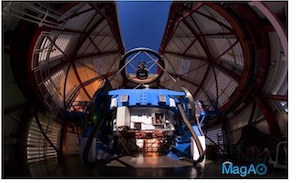New telescope camera captures the sharpest ever images of stars
posted Friday, August 23, 2013 at 12:32 PM EST

If you're trying to take photos of the stars from our planet, you're faced with a pretty serious fundamental problem — the diffraction from the atmosphere means they flicker and "twinkle," making it hard to get a perfectly sharp shot. But a new camera mechanism for a huge optical light telescope in Chile has found away around that problem, and created the sharpest ever view of the night sky.
This breakthrough comes for astronomers at the University of Arizona, the Arcetri Observatory near Florence, Italy and the Carnegie Observatory. They've installed the new hardware at the Clay Magellan Telescope, in Chile, which has a 6.5-meter mirror. In order to counteract the atmospheric interference, the team developed a system for "visible light adaptive optics." This adaptive optic system floats a thin 1.6mm (1/16 inch) curved glass mirror that's 85cm (2.7 feet) across on a magnetic field 30 feet above the primary mirror. This “Adaptive Secondary Mirror” can change its shape at 585 points on its surface, and can do so at a rate of 1000 times per second, effectively adjusting its shape to counteract the atmospheric effects. This results in images that are twice as sharp as visible light images from the Hubble.
This new system, dubbed MagAO, has allowed much sharper images than have ever been captured before at visible wavelengths. The example below is of binary stars Theta 1 Ori C1 and C2 in the e Great Orion Nebulae. We know it's a binary star system, but they're too close to have ever have been resolved in a direct telescope photo. With the new MagAO system, the pair can be resolved independently.
(via Reddit)
